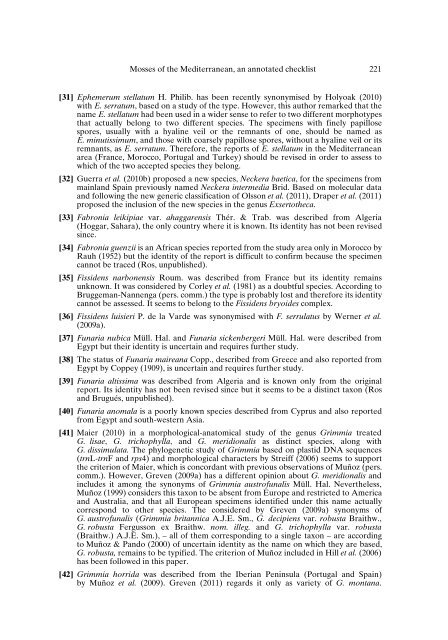Mosses of the Mediterranean, an annotated checklist - Optima-bot.org
Mosses of the Mediterranean, an annotated checklist - Optima-bot.org
Mosses of the Mediterranean, an annotated checklist - Optima-bot.org
Create successful ePaper yourself
Turn your PDF publications into a flip-book with our unique Google optimized e-Paper software.
<strong>Mosses</strong> <strong>of</strong> <strong>the</strong> <strong>Mediterr<strong>an</strong>e<strong>an</strong></strong>, <strong>an</strong> <strong>an</strong>notated <strong>checklist</strong> 221[31] Ephemerum stellatum H. Philib. has been recently synonymised by Holyoak (2010)with E. serratum, based on a study <strong>of</strong> <strong>the</strong> type. However, this author remarked that <strong>the</strong>name E. stellatum had been used in a wider sense to refer to two different morphotypesthat actually belong to two different species. The specimens with finely papillosespores, usually with a hyaline veil or <strong>the</strong> remn<strong>an</strong>ts <strong>of</strong> one, should be named asE. minutissimum, <strong>an</strong>d those with coarsely papillose spores, without a hyaline veil or itsremn<strong>an</strong>ts, as E. serratum. Therefore, <strong>the</strong> reports <strong>of</strong> E. stellatum in <strong>the</strong> <strong>Mediterr<strong>an</strong>e<strong>an</strong></strong>area (Fr<strong>an</strong>ce, Morocco, Portugal <strong>an</strong>d Turkey) should be revised in order to assess towhich <strong>of</strong> <strong>the</strong> two accepted species <strong>the</strong>y belong.[32] Guerra et al. (2010b) proposed a new species, Neckera baetica, for <strong>the</strong> specimens frommainl<strong>an</strong>d Spain previously named Neckera intermedia Brid. Based on molecular data<strong>an</strong>d following <strong>the</strong> new generic classification <strong>of</strong> Olsson et al. (2011), Draper et al. (2011)proposed <strong>the</strong> inclusion <strong>of</strong> <strong>the</strong> new species in <strong>the</strong> genus Exserto<strong>the</strong>ca.[33] Fabronia leikipiae var. ahaggarensis Thér. & Trab. was described from Algeria(Hoggar, Sahara), <strong>the</strong> only country where it is known. Its identity has not been revisedsince.[34] Fabronia guenzii is <strong>an</strong> Afric<strong>an</strong> species reported from <strong>the</strong> study area only in Morocco byRauh (1952) but <strong>the</strong> identity <strong>of</strong> <strong>the</strong> report is difficult to confirm because <strong>the</strong> specimenc<strong>an</strong>not be traced (Ros, unpublished).[35] Fissidens narbonensis Roum. was described from Fr<strong>an</strong>ce but its identity remainsunknown. It was considered by Corley et al. (1981) as a doubtful species. According toBruggem<strong>an</strong>-N<strong>an</strong>nenga (pers. comm.) <strong>the</strong> type is probably lost <strong>an</strong>d <strong>the</strong>refore its identityc<strong>an</strong>not be assessed. It seems to belong to <strong>the</strong> Fissidens bryoides complex.[36] Fissidens luisieri P. de la Varde was synonymised with F. serrulatus by Werner et al.(2009a).[37] Funaria nubica Müll. Hal. <strong>an</strong>d Funaria sickenbergeri Müll. Hal. were described fromEgypt but <strong>the</strong>ir identity is uncertain <strong>an</strong>d requires fur<strong>the</strong>r study.[38] The status <strong>of</strong> Funaria maire<strong>an</strong>a Copp., described from Greece <strong>an</strong>d also reported fromEgypt by Coppey (1909), is uncertain <strong>an</strong>d requires fur<strong>the</strong>r study.[39] Funaria altissima was described from Algeria <strong>an</strong>d is known only from <strong>the</strong> originalreport. Its identity has not been revised since but it seems to be a distinct taxon (Ros<strong>an</strong>d Brugués, unpublished).[40] Funaria <strong>an</strong>omala is a poorly known species described from Cyprus <strong>an</strong>d also reportedfrom Egypt <strong>an</strong>d south-western Asia.[41] Maier (2010) in a morphological-<strong>an</strong>atomical study <strong>of</strong> <strong>the</strong> genus Grimmia treatedG. lisae, G. trichophylla, <strong>an</strong>d G. meridionalis as distinct species, along withG. dissimulata. The phylogenetic study <strong>of</strong> Grimmia based on plastid DNA sequences(trnL-trnF <strong>an</strong>d rps4) <strong>an</strong>d morphological characters by Streiff (2006) seems to support<strong>the</strong> criterion <strong>of</strong> Maier, which is concord<strong>an</strong>t with previous observations <strong>of</strong> Muñoz (pers.comm.). However, Greven (2009a) has a different opinion about G. meridionalis <strong>an</strong>dincludes it among <strong>the</strong> synonyms <strong>of</strong> Grimmia austr<strong>of</strong>unalis Müll. Hal. Never<strong>the</strong>less,Muñoz (1999) considers this taxon to be absent from Europe <strong>an</strong>d restricted to America<strong>an</strong>d Australia, <strong>an</strong>d that all Europe<strong>an</strong> specimens identified under this name actuallycorrespond to o<strong>the</strong>r species. The considered by Greven (2009a) synonyms <strong>of</strong>G. austr<strong>of</strong>unalis (Grimmia brit<strong>an</strong>nica A.J.E. Sm., G. decipiens var. robusta Braithw.,G. robusta Fergusson ex Braithw. nom. illeg. <strong>an</strong>d G. trichophylla var. robusta(Braithw.) A.J.E. Sm.), – all <strong>of</strong> <strong>the</strong>m corresponding to a single taxon – are accordingto Muñoz & P<strong>an</strong>do (2000) <strong>of</strong> uncertain identity as <strong>the</strong> name on which <strong>the</strong>y are based,G. robusta, remains to be typified. The criterion <strong>of</strong> Muñoz included in Hill et al. (2006)has been followed in this paper.[42] Grimmia horrida was described from <strong>the</strong> Iberi<strong>an</strong> Peninsula (Portugal <strong>an</strong>d Spain)by Muñoz et al. (2009). Greven (2011) regards it only as variety <strong>of</strong> G. mont<strong>an</strong>a.






